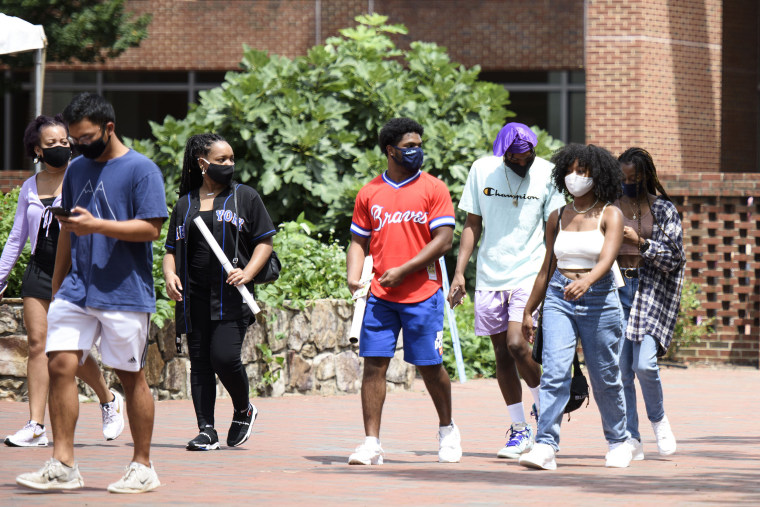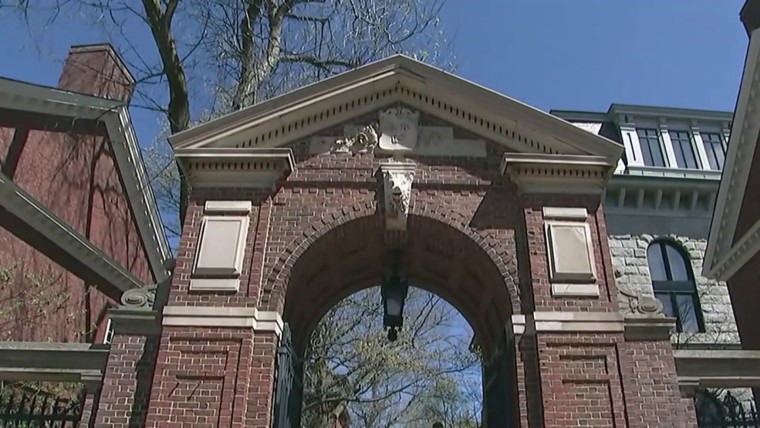As affirmative action programs face their biggest threat in decades, experts say Black and Latino students would experience fewer job and financial opportunities.

The campus of the University of North Carolina in Chapel Hill
.Melissa Sue Gerrits / Getty Images
Jan. 26, 2022, 4:00 AM MST / Updated Jan. 26, 2022
By Tat Bellamy-Walker
Experts say that Black and Latino students would suffer disproportionately if the Supreme Court decides to reverse a long-standing policy on affirmative action programs in the U.S.
On Monday, the Supreme Court said it would hear two cases challenging race-conscious admissions at Harvard University and the University of North Carolina.
If the court rules against race-conscious college admissions programs, also known as affirmative action, it could have an outsize effect on Black and Latino college students.

Supreme Court agrees to hear challenges to affirmative action in college admissions
Jan. 26, 2022, 4:00 AM MST / Updated Jan. 26, 2022
By Tat Bellamy-Walker
Experts say that Black and Latino students would suffer disproportionately if the Supreme Court decides to reverse a long-standing policy on affirmative action programs in the U.S.
On Monday, the Supreme Court said it would hear two cases challenging race-conscious admissions at Harvard University and the University of North Carolina.
If the court rules against race-conscious college admissions programs, also known as affirmative action, it could have an outsize effect on Black and Latino college students.

Supreme Court agrees to hear challenges to affirmative action in college admissions
JAN. 24, 202201:01
One of the most comprehensive studies on the issue, published in 2020, found that Black and Latino students suffered after California’s public universities banned affirmative action in a 1996 ballot initiative. Following the ban, more students of color enrolled at less selective institutions and, as a result, were less likely to get college degrees, graduate degrees or jobs in the STEM fields.
“When Black and Hispanic students lost access to California’s more selective universities, they lost access to this public investment,” Zachary Bleemer, the study’s author, told NBC News.
The findings also showed that the ban discouraged thousands of students of color annually from applying to the University of California system, although most still met the qualifications for enrollment.
Bleemer, a postdoctoral fellow with Opportunity Insights, a research group at Harvard University, added that these losses were also felt in the labor market.
“Black and Hispanic young workers ended up with relatively lower-paying jobs in the state over the next, at least, 15 years,” he said.
Cara McClellan, an assistant counsel at the NAACPs Legal and Education Defense Fund, said it would be unusual for the court to go against years of upholding affirmative action.
“Any ruling that calls into question the legality of race-conscious admissions would be a huge reversal of more than 40 years of Supreme Court precedent,” McClellan said. “It would be quite a radical act for that to be the outcome.”
Such an outcome, McClellan said, would dramatically reduce racial diversity at private and public universities.
“The end of holistic admissions would lead to a severe reduction in the number of Black and Latino students at Harvard and, if the ruling is broader, at other universities,” McClellan said. “Race-conscious admissions has been key to providing diversity on campus.”
Natasha Warikoo, a professor of sociology at Tufts University and author of “The Diversity Bargain,” said Black and Latino students who do get into more selective schools would also feel the brunt of a reversal.
“They will have a much smaller community of same-race peers, and are more likely to be the only underrepresented minority in a class and have less access to social networks that we know are important for students of color on their college campuses,” Warikoo said. “I really see it as this two-fold impact on Black and Latino students.”
The lawsuits were lodged on behalf of students by Edward Blum, a conservative legal strategist and long-time opponent of affirmative action. They claim that Harvard’s undergraduate admissions system discriminates against Asian American students and that UNC’s discriminated against both Asian American and white students.
In 2003, the landmark Supreme Court ruling Grutter v. Bollinger upheld the use of affirmative action admissions policies at the University of Michigan Law School. Blum wants the courts to overrule that decision. In 2016, the courts upheld the constitutionality of affirmative action in Fisher v. University of Texas.
While the Supreme Court has rejected similar challenges to affirmative action, the addition of Trump appointees Brett Kavanaugh and Amy Coney Barrett as justices could change that.
Marshall Anthony Jr., an associate director of policy and advocacy for higher education at the Center for American Progress, a left-leaning think tank, said he is concerned about how the court might rule in light of the justice's conservative leanings. He also expressed concern over the court's willingness to hear cases that could dismantle precedence, such as one case the court is currently weighing regarding abortion access, and the 2013 decision by the court to weaken bans on discriminatory voting practices.
“Unfortunately, with a more conservative-leaning bench, we’re seeing a lot of the policies meant to advance civil and human rights become under attack,” Anthony said. “We need a higher ed system that is accessible to all and affordable to all … and affirmative action is one of those policy vehicles to ensure that actually happens.”
One of the most comprehensive studies on the issue, published in 2020, found that Black and Latino students suffered after California’s public universities banned affirmative action in a 1996 ballot initiative. Following the ban, more students of color enrolled at less selective institutions and, as a result, were less likely to get college degrees, graduate degrees or jobs in the STEM fields.
“When Black and Hispanic students lost access to California’s more selective universities, they lost access to this public investment,” Zachary Bleemer, the study’s author, told NBC News.
The findings also showed that the ban discouraged thousands of students of color annually from applying to the University of California system, although most still met the qualifications for enrollment.
Bleemer, a postdoctoral fellow with Opportunity Insights, a research group at Harvard University, added that these losses were also felt in the labor market.
“Black and Hispanic young workers ended up with relatively lower-paying jobs in the state over the next, at least, 15 years,” he said.
Cara McClellan, an assistant counsel at the NAACPs Legal and Education Defense Fund, said it would be unusual for the court to go against years of upholding affirmative action.
“Any ruling that calls into question the legality of race-conscious admissions would be a huge reversal of more than 40 years of Supreme Court precedent,” McClellan said. “It would be quite a radical act for that to be the outcome.”
Such an outcome, McClellan said, would dramatically reduce racial diversity at private and public universities.
“The end of holistic admissions would lead to a severe reduction in the number of Black and Latino students at Harvard and, if the ruling is broader, at other universities,” McClellan said. “Race-conscious admissions has been key to providing diversity on campus.”
Natasha Warikoo, a professor of sociology at Tufts University and author of “The Diversity Bargain,” said Black and Latino students who do get into more selective schools would also feel the brunt of a reversal.
“They will have a much smaller community of same-race peers, and are more likely to be the only underrepresented minority in a class and have less access to social networks that we know are important for students of color on their college campuses,” Warikoo said. “I really see it as this two-fold impact on Black and Latino students.”
The lawsuits were lodged on behalf of students by Edward Blum, a conservative legal strategist and long-time opponent of affirmative action. They claim that Harvard’s undergraduate admissions system discriminates against Asian American students and that UNC’s discriminated against both Asian American and white students.
In 2003, the landmark Supreme Court ruling Grutter v. Bollinger upheld the use of affirmative action admissions policies at the University of Michigan Law School. Blum wants the courts to overrule that decision. In 2016, the courts upheld the constitutionality of affirmative action in Fisher v. University of Texas.
While the Supreme Court has rejected similar challenges to affirmative action, the addition of Trump appointees Brett Kavanaugh and Amy Coney Barrett as justices could change that.
Marshall Anthony Jr., an associate director of policy and advocacy for higher education at the Center for American Progress, a left-leaning think tank, said he is concerned about how the court might rule in light of the justice's conservative leanings. He also expressed concern over the court's willingness to hear cases that could dismantle precedence, such as one case the court is currently weighing regarding abortion access, and the 2013 decision by the court to weaken bans on discriminatory voting practices.
“Unfortunately, with a more conservative-leaning bench, we’re seeing a lot of the policies meant to advance civil and human rights become under attack,” Anthony said. “We need a higher ed system that is accessible to all and affordable to all … and affirmative action is one of those policy vehicles to ensure that actually happens.”
No comments:
Post a Comment